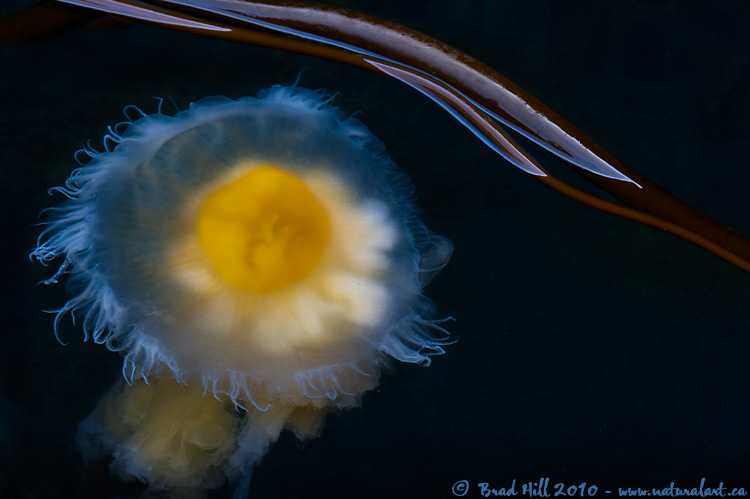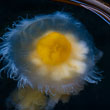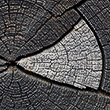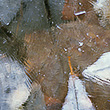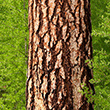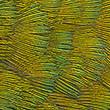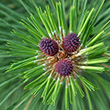Availability: Undetermined - Enquiries?
In the Field
Face on Your Egg? Northern Vancouver Island, BC, Canada. August 27, 2010.
What's that old saying? Something about having "egg on your face?" This image is kind of the reverse situation so it seems appropriate to title the image "Face on Your Egg"! The jellyfish pictured here has two common names - the "Egg Yolk Jellyfish" and the "Fried Egg Jellyfish." They're impressive jellyfish and the bell/medusa often measures up to 60 cm (or 2') across and their tentacles can be up to 20' in length. This specimen was about 14-16' across.
About the face in the egg yolk (which I'm SURE you saw at first glance!)? No idea what's going on there! An apparition? A Virgin Mary-like thing? A hint of the evolutionary goal of the jellyfish? Something the jellyfish recently ate? Don't know. But kinda fun! And, if I'm being honest, I have to say that I never saw the face while I was shooting the image - but I DID notice it at first glance when I was reviewing the images on my computer.
I commonly mention that I like very simple images with few distractions within them. This would definitely be an example of a simple image! Pretty much all that's here is one specimen of fauna (the jellyfish) and a bit of fauna (the segment of bull kelp along the top of the image). In a way, the image is as much about composition and the beautiful colours of nature as it is about the subjects.
Shooting objects on or just below the surface of water can be quite tricky and the biggest obstacle to overcome is finding a way to reduce or remove distracting reflections from the water's surface. I shot this image under completely blue skies (thus the beautiful blue hues in the image), but we were in deep shadow along the face of a cliff (which helped kill some of the reflection and glare). But, just as importantly, I shot this scene using a circular polarizing filter, which helps reduce reflections quite dramatically. Old-time nature photographers (the film guys!) never went into the field without polarizer, but I've noticed fewer members of the "new generation" (the digital-only photographers with no film background) carry or use them. If there's only ONE filter a nature photographer has, it SHOULD be a polarizing filter!
Behind the Camera
Face on Your Egg? Northern Vancouver Island, BC, Canada. August 27, 2010.
Digital Capture; RAW 14-bit format; ISO 2000.
Nikon D3s with Nikkor 70-200mm f2.8 VR II lens (@ 135mm) hand-held and shot from moving zodiac boat. VR on and set to "Active" mode.
1/160s @ f8; -0.67 stop compensation from matrix-metered exposure setting.
At the Computer
Face on Your Egg? Northern Vancouver Island, BC, Canada. August 27, 2010.
RAW Conversion to 16-bit PSD file, including first-pass/capture sharpening and noise reduction using Adobe Lightroom (Release Candidate vers. 3.3). Two raw conversions at different exposure settings: -0.35 stops to darken the water; +0.35 stops for portions of the jellyfish and kelp.
Further digital corrections on 16-bit PSD file using Adobe Photoshop CS5. Photoshop adjustments included compositing of two exposure versions, selective contrast adjustments, selective saturation and desaturation of colours, and selective sharpening for web output.
Conservation
Face on Your Egg? Northern Vancouver Island, BC, Canada. August 27, 2010.
Information to follow.












